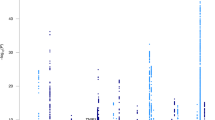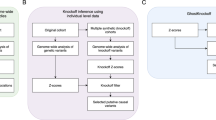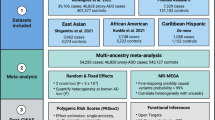Abstract
The successful discovery of genes that cause rare monogenic disorders has dominated our understanding of the genetic basis of neurodegenerative disease. The emergence of robust genome-wide association methodologies promises to explain the genetic etiology of the common sporadic forms of complex diseases. In addition to revealing the genetic susceptibility of neurodegenerative disease, genome-wide association studies (GWASs) should also be an unbiased generator of molecules that are relevant in disease pathogenesis. Despite this exciting potential, GWAS results have varied in their consistency and their ability to deliver these aims. The largest challenge that faces neuroscientists is the interpretation of the results of GWASs and the translation of the genetic findings into functional mechanisms that are biologically important in disease pathogenesis and, ultimately, treatment design. We examine recent results from GWASs of Alzheimer's disease and Parkinson's disease and explore their use and limitations. We further reflect on how these results may expedite progress in understanding and influencing the molecular pathogenesis of neurodegeneration.
This is a preview of subscription content, access via your institution
Access options
Subscribe to this journal
Receive 12 print issues and online access
$209.00 per year
only $17.42 per issue
Buy this article
- Purchase on Springer Link
- Instant access to full article PDF
Prices may be subject to local taxes which are calculated during checkout
Similar content being viewed by others
References
Schork, N.J., Murray, S.S., Frazer, K.A. & Topol, E.J. Common vs. rare allele hypotheses for complex diseases. Curr. Opin. Genet. Dev. 19, 212–219 (2009).
Tsai, M.S. et al. Apolipoprotein E: a risk factor for Alzheimer's disease. Am. J. Hum. Genet. 54, 643–649 (1994).
Frazer, K.A. et al. A second generation human haplotype map of over 3.1 million SNPs. Nature 449, 851–861 (2007).
Wellcome Trust Case Control Consortium. Genome-wide association study of 14,000 cases of seven common diseases and 3,000 shared controls. Nature 447, 661–678 (2007).
McCarthy, M.I. et al. Genome-wide association studies for complex traits: consensus, uncertainty and challenges. Nat. Rev. Genet. 9, 356–369 (2008).
Wang, W.Y., Barratt, B.J., Clayton, D.G. & Todd, J.A. Genome-wide association studies: theoretical and practical concerns. Nat. Rev. Genet. 6, 109–118 (2005).
Simón-Sánchez, J. & Singleton, A. Genome-wide association studies in neurological disorders. Lancet Neurol. 7, 1067–1072 (2008).
Frazer, K.A., Murray, S.S., Schork, N.J. & Topol, E.J. Human genetic variation and its contribution to complex traits. Nat. Rev. Genet. 10, 241–251 (2009).
Simón-Sánchez, J. et al. Genome-wide association study reveals genetic risk underlying Parkinson's disease. Nat. Genet. 41, 1308–1312 (2009).
Satake, W. et al. Genome-wide association study identifies common variants at four loci as genetic risk factors for Parkinson's disease. Nat. Genet. 41, 1303–1307 (2009).
Edwards, T.L. et al. Genome-wide association study confirms SNPs in SNCA and the MAPT region as common risk factors for Parkinson disease. Ann. Hum. Genet. 74, 97–109 (2010).
Pittman, A.M., Fung, H.C., & de Silva, R. Untangling the tau gene association with neurodegenerative disorders. Hum. Mol. Genet. 15, R188–R195 (2006).
Hardy, J. A hundred years of Alzheimer's disease research. Neuron 52, 3–13 (2006).
Small, S.A. & Duff, K. Linking Abeta and tau in late-onset Alzheimer's disease: a dual pathway hypothesis. Neuron 60, 534–542 (2008).
Lee, H.C. Multiplicity of Ca2+ messengers and Ca2+ stores: a perspective from cyclic ADP-ribose and NAADP. Curr. Mol. Med. 4, 227–237 (2004).
Surmeier, D.J., Guzman, J.N. & Sanchez-Padilla, J. Calcium, cellular aging, and selective neuronal vulnerability in Parkinson's disease. Cell Calcium 47, 175–182 (2010).
Nuutinen, T., Suuronen, T., Kauppinen, A. & Salminen, A. Clusterin: a forgotten player in Alzheimer's disease. Brain Res. Brain Res. Rev. 61, 89–104 (2009).
Michel, D., Chatelain, G., North, S. & Brun, G. Stress-induced transcription of the clusterin/apoJ gene. Biochem. J. 328, 45–50 (1997).
McGeer, P.L., Kawamata, T. & Walker, D.G. Distribution of clusterin in Alzheimer brain tissue. Brain Res. 579, 337–341 (1992).
DeMattos, R.B. et al. Clusterin promotes amyloid plaque formation and is critical for neuritic toxicity in a mouse model of Alzheimer's disease. Proc. Natl. Acad. Sci. USA 99, 10843–10848 (2002).
Bell, R.D. et al. Transport pathways for clearance of human Alzheimer's amyloid beta-peptide and apolipoproteins E and J in the mouse central nervous system. J. Cereb. Blood Flow Metab. 27, 909–918 (2007).
Harel, A., Wu, F., Mattson, M.P., Morris, C.M. & Yao, P.J. Evidence for CALM in directing VAMP2 trafficking. Traffic 9, 417–429 (2008).
Nordstedt, C., Caporaso, G.L., Thyberg, J., Gandy, S.E. & Greengard, P. Identification of the Alzheimer beta/A4 amyloid precursor protein in clathrin-coated vesicles purified from PC12 cells. J. Biol. Chem. 268, 608–612 (1993).
Carey, R.M., Balcz, B.A., Lopez-Coviella, I. & Slack, B.E. Inhibition of dynamin-dependent endocytosis increases shedding of the amyloid precursor protein ectodomain and reduces generation of amyloid beta protein. BMC Cell Biol. 6, 30 (2005).
Zhou, J., Fonseca, M.I., Pisalyaput, K. & Tenner, A.J. Complement C3 and C4 expression in C1q sufficient and deficient mouse models of Alzheimer's disease. J. Neurochem. 106, 2080–2092 (2008).
Webster, S., Bradt, B., Rogers, J. & Cooper, N. Aggregation state-dependent activation of the classical complement pathway by the amyloid beta peptide. J. Neurochem. 69, 388–398 (1997).
Rogers, J. et al. Peripheral clearance of amyloid beta peptide by complement C3-dependent adherence to erythrocytes. Neurobiol. Aging 27, 1733–1739 (2006).
Hunter, D.J. & Kraft, P. Drinking from the fire hose—statistical issues in genomewide association studies. N. Engl. J. Med. 357, 436–439 (2007).
Ng, P.C. et al. Genetic variation in an individual human exome. PLoS Genet. 4, e1000160 (2008).
Dickson, S.P., Wang, K., Krantz, I., Hakonarson, H. & Goldstein, D.B. Rare variants create synthetic genome-wide associations. PLoS Biol. 8, e1000294 (2010).
Lambert, J.C. et al. Genome-wide association study identifies variants at CLU and CR1 associated with Alzheimer's disease. Nat. Genet. 41, 1094–1099 (2009).
Harold, D. et al. Genome-wide association study identifies variants at CLU and PICALM associated with Alzheimer's disease. Nat. Genet. 41, 1088–1093 (2009).
Brouwers, N., Sleegers, K. & Van, B.C. Molecular genetics of Alzheimer's disease: an update. Ann. Med. 40, 562–583 (2008).
Goate, A. et al. Segregation of a missense mutation in the amyloid precursor protein gene with familial Alzheimer's disease. Nature 349, 704–706 (1991).
Rogaev, E.I. et al. Familial Alzheimer's disease in kindreds with missense mutations in a gene on chromosome 1 related to the Alzheimer's disease type 3 gene. Nature 376, 775–778 (1995).
Sherrington, R. et al. Cloning of a gene bearing missense mutations in early-onset familial Alzheimer's disease. Nature 375, 754–760 (1995).
Holmes, C. et al. Long-term effects of Abeta42 immunisation in Alzheimer's disease: follow-up of a randomised, placebo-controlled phase I trial. Lancet 372, 216–223 (2008).
Bales, K.R. et al. Lack of apolipoprotein E dramatically reduces amyloid beta-peptide deposition. Nat. Genet. 17, 263–264 (1997).
Lesage, S. & Brice, A. Parkinson's disease: from monogenic forms to genetic susceptibility factors. Hum. Mol. Genet. 18, R48–R59 (2009).
Polymeropoulos, M.H. et al. Mutation in the alpha-synuclein gene identified in families with Parkinson's disease. Science 276, 2045–2047 (1997).
Singleton, A.B. et al. alpha-Synuclein locus triplication causes Parkinson's disease. Science 302, 841 (2003).
Paisán-Ruíz, C. et al. Cloning of the gene containing mutations that cause PARK8-linked Parkinson's disease. Neuron 44, 595–600 (2004).
Gilks, W.P. et al. A common LRRK2 mutation in idiopathic Parkinson's disease. Lancet 365, 415–416 (2005).
Healy, D.G. et al. Phenotype, genotype, and worldwide genetic penetrance of LRRK2-associated Parkinson's disease: a case-control study. Lancet Neurol. 7, 583–590 (2008).
Lesage, S. et al. LRRK2 G2019S as a cause of Parkinson's disease in North African Arabs. N. Engl. J. Med. 354, 422–423 (2006).
Kitada, T. et al. Mutations in the parkin gene cause autosomal recessive juvenile parkinsonism. Nature 392, 605–608 (1998).
Valente, E.M. et al. Hereditary early-onset Parkinson's disease caused by mutations in PINK1. Science 304, 1158–1160 (2004).
Bonifati, V. et al. Mutations in the DJ-1 gene associated with autosomal recessive early-onset parkinsonism. Science 299, 256–259 (2003).
Neumann, J. et al. Glucocerebrosidase mutations in clinical and pathologically proven Parkinson's disease. Brain 132, 1783–1794 (2009).
Acknowledgements
The authors acknowledge the support of the Wellcome Trust, the Medical Research Council (Neurodegeneration strategic award) and Parkinson's UK.
Author information
Authors and Affiliations
Corresponding author
Ethics declarations
Competing interests
The authors declare no competing financial interests.
Rights and permissions
About this article
Cite this article
Gandhi, S., Wood, N. Genome-wide association studies: the key to unlocking neurodegeneration?. Nat Neurosci 13, 789–794 (2010). https://doi.org/10.1038/nn.2584
Issue Date:
DOI: https://doi.org/10.1038/nn.2584
This article is cited by
-
Clinical biomarkers for Lewy body diseases
Cell & Bioscience (2023)
-
DeepGAMI: deep biologically guided auxiliary learning for multimodal integration and imputation to improve genotype–phenotype prediction
Genome Medicine (2023)
-
A telescope GWAS analysis strategy, based on SNPs-genes-pathways ensamble and on multivariate algorithms, to characterize late onset Alzheimer’s disease
Scientific Reports (2020)
-
LRRK2 deficiency induced mitochondrial Ca2+ efflux inhibition can be rescued by Na+/Ca2+/Li+ exchanger upregulation
Cell Death & Disease (2019)
-
Endothelial Progenitor Cells Modulate Inflammation-Associated Stroke Vasculome
Stem Cell Reviews and Reports (2019)



